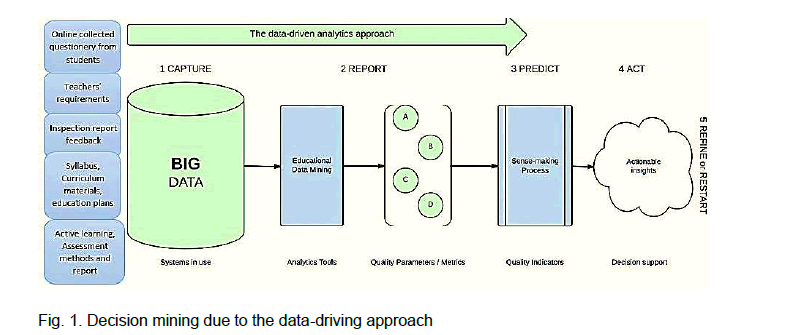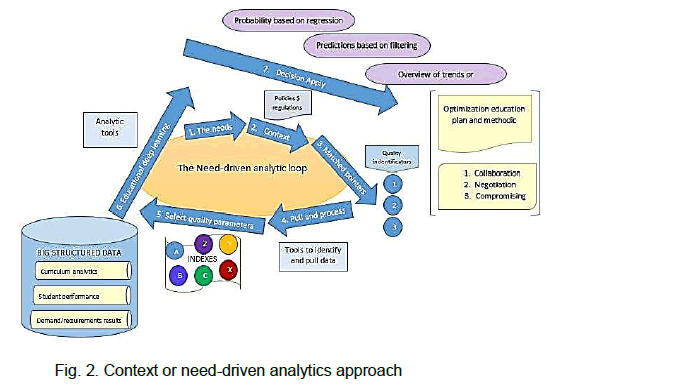
"AN INVESTMENT IN KNOWLEDGE ALWAYS PAYS THE BEST INTEREST" BENJAMIN FRANKLIN

"AN INVESTMENT IN KNOWLEDGE ALWAYS PAYS THE BEST INTEREST" BENJAMIN FRANKLIN

Review Article - (2021) Volume 58, Issue 3
Received: Dec 02, 2021 Published: Dec 23, 2021, DOI: 10.36962/gbssjar/58.3.004
In this chapter, we provide information on how much information of both participants of curriculum can be analyzed to provide readers with insights into the field of big education data and various stakeholders, and thus to promote data driven actions to improve the quality of teaching techniques. We introduce the readers to the field of the methods used in international practice have been researched, but we would like to create a platform in which the aspirations of both parties in education-teachers and students-coincide, and this is the main goal of our work. In this method, the existing deep learning and data mining mechanisms are applied, their opinions are compared, commonalities (trends) are found, and the result is applied to the teaching process as a suggestion. The concept of quality improvement in education is presented in relation to two factors: (a) the impact of academic processes on the development of the teaching/learning process and (b) the implementation of curriculum and education plans presented as a result of practical application.
http://www.environmentjournals.com/
http://www.eventsupporting.org/
http://www.escientificreviews.com/
http://www.openaccesspublications.com/
http://www.imedpub.org/
http://www.jpeerreview.com/
http://www.escientificres.com/
http://www.scholarlyjournals.org/
http://www.eclinicaljournals.com/
http://www.scischolarsjournal.com/
http://www.intlscholarsjournal.com/
http://www.scholarsresjournal.com/
http://www.sysrevpharma.org/
http://www.environjournal.com/
http://www.jpeerres.com/
http://www.managjournal.org/
http://www.emedicalhub.org/
http://www.biomedresj.org/
http://www.aaccongress.com/
http://www.eclinicalres.org/
http://www.scholarlymed.com/
http://www.eclinicalres.com/
http://www.theresearchpub.com/
http://www.imedpubscholars.com/
http://www.scholarcentral.org/
http://www.journalpublications.org/
http://www.scholarlypub.com/
http://www.imedpublishing.org/
http://www.emedsci.com/
http://www.longdomjournals.org/
http://www.longdomjournal.org/
http://www.emedicalcentral.com/
http://www.lexisjournal.com/
http://www.geneticjournals.com/
http://www.scitecjournals.com/
http://www.microbialjournals.org/
http://www.engjournals.org/
http://www.eneurologyjournals.com/
http://www.pulsusjournal.org/
http://www.biochemjournal.org/
http://www.epharmacentral.com/
http://www.eclinicalsci.com/
http://www.eclinicalcentral.com/
http://www.eclinmed.com/
http://www.jopenaccess.org/
http://www.peerreviewedjournals.com/
http://www.immunologyjournals.com/
http://www.neurologyjournals.org/
http://www.clinicalmedicaljournals.com/
http://www.molecularbiologyjournals.com/
http://www.geneticsjournals.com/
http://www.biochemistryjournals.org/
http://www.psychiatryjournals.org/
http://www.pharmajournals.org/
http://www.alliedresearch.org/
http://www.medicalres.org/
http://www.medicalresjournals.com/
http://www.alliedsciences.org/
http://www.pediatricsjournals.org/
http://www.oncologyinsights.org/
Teaching techniques, Elaborate demands, Compromised needs, Quality curriculum, Big educational data, Analytics.
At a time when all traditional industry areas are being transformed and upgraded for greater efficiency, so this must be reflected in education. In the traditional education model, the teacher played a key role in the teaching process and did not take into account the interests and needs of the students. Students were only required to master the basic knowledge, experiences and skills they had instilled. Learners were tested under the supervision of teachers with pre-arranged exams and home-works. Traditional method of teaching is when a teacher directs students to learn through memorization and recitation techniques and not developing their critical thinking, problem solving and decision making skills however modern or in the other word compromising approach to teaching involves a more interacting, student-teacher-based of teaching. This means that it becomes a method that takes into account the demands of students in teaching, and as a result of the method to be applied, they have an active learning (perception) change. However, it is not always possible when both sides who play a leading role in the teaching process, the students demands and teachers requirements intersect. Nevertheless, both sides are committed to improving teaching and modernizing effective training methodologies / techniques. Effective learning is a result of productive teaching which has to be predicated on an understanding of how students learn. The objective of the effectiveness is to bring about learning, and there has to be knowledge and practical skills about learners’ demand for teaching to be successful. For teaching and learning to be effective, their ideas must be integrated, but it is not easy to find a correlation between requirements and demands at the same time.
Therefore, we need to create such a mechanism that can be applied both to the effective learning of students and at the same time to the professional development of the teachers. Such synergic practice is a key aspect of lifelong learning. The essence of this mechanism is that it is always efficient and justifying itself when applied to the teaching process. Professionalism cannot be learned solely through conventional teaching methods it requires role models, futuristic mechanism, self-practice, observation of practice and mentors experience reflection upon that practice. I would like to show that there are some international practices in this area that meet pre-defined criteria.
1. Learning analytics methods conducted a systematic review with the ambition to answer three questions: What does the research on learning analytics say about methods used in LA; what does it say about benefits of using LA, and what does it say about challenges encountered when using LA, LA found that careful analysis of big data may help stakeholders to elicit useful information that can benefit educational institutions, students, instructors, and researchers..
2. Learning design methods use multiple regression models when linking 151 modules and 111.256 students with student behavior, satisfaction and performance at the Open University (OU), UK. The OU has used leaner feedback to improve students’ learning experience and learning designs for 30 years. Learning Design (LD) is described as a methodology for enabling teachers/ designers to make more informed decisions in how they go about designing learning activities and interventions, which are pedagogically informed and make effective use of appropriate resources and technologies.
3. Pedagogy, space, technology investigated instructional components and class activities that support active learning in a Collaborative Learning Studio (CLS) with 29 students and how spatial and technological features reflect design and implementation processes. Active learning is used instructional approaches that actively engage students in the learning process through collaboration, cooperation and discussions, rather than having them passively receive information from their instructors. Following Table 1 reveals definition of the method what emphasizes the specific perceptions inside of its context.
| Collaborative Learning Studio (CLS) | Technologies |
|---|---|
| Designed for active learning small-group activities movable chairs and monitors in U-shaped student tables | Video wall, Control panels, Push capabilities, Projector screens, Student monitors, Instructor desktop, Wireless microphone, Document cameras, Student desktop and push-to-talk microphone on student tables. |
Table 1. Schema of CLS and technologies
Problem solution
Although the applied investigations we have listed above are well-known and actual for now, each has its own set of shortcomings as Data tracking, Data collection, Data evaluation and analysis, learning environment optimization etc.
In this Fig 1, the main point of view begins with the data and ends with the decision. The main focus is on the information collected from students and teachers (questionnaire results, assessment results, textbooks, syllabus, curriculum methodology, education plan, subjects, its lecture, practice and laboratory hours, self-employed works, etc.) and the necessary mechanism for their collection, storage, cleaning, transmission, and processing. Questionnaire with students are planned to be conducted online so that they feel more comfortable responding in their suggestions. The student survey allows students to vote their issues, needs, and desires, feedback on how teachers can change his or her instruction to help them perform more productive and skill-based in class. The standard questionnaire and the habitual procedures may have lacked flexibility and been inappropriate for innovative forms of teaching methodology. There is no evidence, this study what means teachers/student questionnaires should not be informal, but should be based on some criteria and orientations. Thus, these questions should not deviation from internationally agreed education goals and policies (UNESCO), as well as the decisions taken by the Ministry of Education. Proposals for criteria are as following:

Figure 1: Decision mining due to the data-driving approach
1. Assessment of learning outcomes-Students can provide opinions on such dimensions of teaching as the effectiveness of the teachers’ pedagogy, his or her proficiency and fairness in assessing learning, and how well he or she advises students on issues relating to course. Students also can assess their own learning relative to course syllabus, thereby providing some evidence of whether they have learned what the teacher intended.
2. Expanding the teaching of specialty-oriented subjects by making changes to existing curricula in accordance with the new educational standards will allow students who make new choices and thus create new norms to open such ways to specialize in their chosen specialties. Which should be preferred in theoretical, practical and laboratory hours during the delivery of knowledge in the teaching process should be adapted to the negotiation of teachers and students. This compromising has to be balanced with good information, guidance and structured programs to ensure that learning efforts are not wasted.
3. Problem-based learning-focuses in organizing the curricular content around problem scenarios rather than subjects or disciplines. Students work in groups or teams to solve or manage these situations but they are not expected to acquire a predetermined series of right answers. Instead they are expected to engage with designing customized solutions for problems and issues and the complex situation presented to them and decide what information they need to learn and what skills they need to gain in order to manage the situation effectively.
4. Instructional conversation-such conversation reveals the knowledge, skills, and values enabling the teacher to contextualizing teaching to fit the learner’s experience base. This concept may appear like a paradox, because conversation implies equality and responsiveness. But the instructional conversation is based on responsibilities that are fundamentally different from those of traditional lessons.
5. Experience innovative technology-lets students create small groups in class and work on a project or task, teachers create a number of interesting tasks with these tools, easily invite specialists to provide a sophisticated lecture to whole class through Skype and help them get a better hang of things, turn chapter topics into games. Invest in developing own transformational learning content can be so effective in a classroom.
Because responses from students collected to a database are considered large amounts of data, high-level mining methods, high-analytics, and big data methods are used to ensure data-based improvements of processing and procedures. It is difficult to understand all this information, evaluate trends, and explore all possible associations. This step involves creating an overview to scan by using different tools to create queries, examine information and identify trends and patterns. In this step, the deep learning methods used for data processing are required to find trends like collaboration, negotiation, compromising in matching between student’s demands and teacher’s requirements. Based on the processing of previous steps, optimization (in the curriculum and methodology) predicts trends and decides actions that can be precise and accurate, but still remains as a suggestion. Predictions and probabilities that support decision making are be derived. Following schema (Fig.2) describes our goal as explained above so detailed statements crystal clear.

Figure 2: Context or need-driven analytics approach
This way a new analytics approach called context or need-driven analytics. This approach is more suitable for less qualified group of students in data analysis techniques such as educators and decision-makers. The approach starts from the need for a decision and goes through the analysis of relevant data which could support the both sides-key objects of teaching and Learning process decisions. Every detail is important: the stakeholders, the circumstances, particular needs, economic boundaries, accessibility of resources, organizational environment, conditions, policies, technological options, timing and other factors which influence the decisions. These data are selected, prepared, assessed, compared and produced by analytics tools utilizing particular mining and deep learning methods.
In the final process, the proposed methods and tools should be reflected optimizing the teaching process, updating and upgrading the syllabus and curriculum, improving teaching techniques/technologies applicable for class in which we can see the relevance of student-teacher views synergy as well as monitoring, feedback and evaluation of the methodology’s impact create new data and evidence that can be used to start the loop again with improved performance.